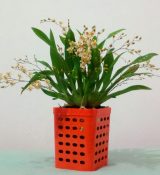Blooming Oncidium Orchids
Author: Celeste Booth4 Comments
Blooming, Care and Culture, Growing Indoors, Growing Outdoors

The Oncidium family is very large and includes many flower varieties. The most common flower variety is often referred to as the “dancing lady”. This instruction sheet deals with Oncidium types that have thin leaves, pseudobulbs, and branching sprays with flowers colored in yellow and mahogany.
- Light and Shade – Grow in bright diffused light; east or west windows are ideal. South windows will work but one should be careful of the brilliant sun that will come in during the fall through spring months. If you have miniblinds or sheer curtains, you can break the light so that it is more diffused. One of the best types of artificial light you can provide for your orchids is high-pressure sodium or metal halide fixtures.
- Temperature – Ideal night temperatures (fall, winter, and spring months) are 60°-64°. Ideal daytime temperatures are 70°-85°. Summer temperatures are generally a few degrees warmer.
- Watering – Water when the mix just approaches dryness. This will mean about every 5-7 days. A way to check the mix for moisture is by sticking a wooden pencil into the mix about 3”-4”. When you pull the pencil out, check the wooden end. If it has turned dark in color, the mix is still wet and you should wait a day or two. Oncidiums prefer clean water without a lot of mineral content. Therefore growing best when you use distilled, reverse osmosis or rainwater. Do not use softened water.
- Humidity – Humidity levels for Oncidium orchids should be kept at 40% or above.
- Blooming – Depending on the variety the flowering season can be at any time of year, but is generally heaviest in the fall and spring. Many hybrids can bloom 2-3 times per year. In order to initiate the flower spikes, it is important to grow the plant in an area where the night temperatures fall below 65°. Usually plants growing by a window are a couple of degrees cooler than the rest of the house. The flower spikes on Oncidiums generally grow to a medium or tall length and branch out in several directions. Keep a close eye on the spike (when it begins to produce flower buds) for aphids. Oncidiums are one of the most favored orchids of the aphid bug.
- Fertilizing – For tap or well water, fertilize with Grow More Urea Free 20-10-20, at the rate of 1/2 tsp. per gallon. Feed every other watering during the summer, and every third watering in winter. Another highly recommended fertilizer is Green Jungle Orchid Food, especially formulated to work with rain, distilled, reverse osmosis water or water low in alkalinity. Fertilize with Green Jungle every time you water, all year round.
- Potting – Repot every 1 to 2 years as the mix breaks down or as the plant outgrows the pot. Plants potted in a bark mixture should be carefully pulled out of the pot. Clean off the roots of the old mix, being careful not to break the good roots. However, breaking roots when repotting is inevitable. Roots that are bad and should be cut off are those that are brown and mushy or papery. Those roots that are white or tan and are firm to the touch should be left alone. Simply place the plant into a new pot, placing the oldest growth towards the back of the pot so there is room for the newer growths to develop for about 1-2 years. Oncidiums can be divided when there are 6 or more pseudobulbs. Divide, leaving 3 growths per each division. Generally Oncidiums are planted in either an orchid bark mix or New Zealand sphagnum moss mixed with tree fern fiber.
- More on Equitant Oncidium Orchid Blooming…
Header image via Wikimedia
4 Responses to “Blooming Oncidium Orchids”
Leave a Reply


Ask an Expert
Questions about orchids?
Our experts love a challenge!
Photo of the Week
Submit your photo to be featured on the blog!
More Photo of the Week Winners
Submit Photo








I received an orchid as a gift. I would like to know do I cut the shoots that the blooms were on off and how far down do I cut.
I have many plants but this is the first time for Orchids.
There is no need to cut them unless you want to. The plant will naturally absorb the nutrients left in the shoots and then they will fall off. Good luck with your orchid!
I have acquired my first orchid and all the blooms fell off after a few weeks. Is the plant hibernating? When can I expect new blooms?
I ordered a orchid that has pseudobulbs and it got freez burn in shipping do I cut off the dead branches to the bulbs or leave them two of the p.bulbs are frozen do I cut the branches back on the one p.bulb back to the bulb is ok but the branches are dead all the leaves fell off.